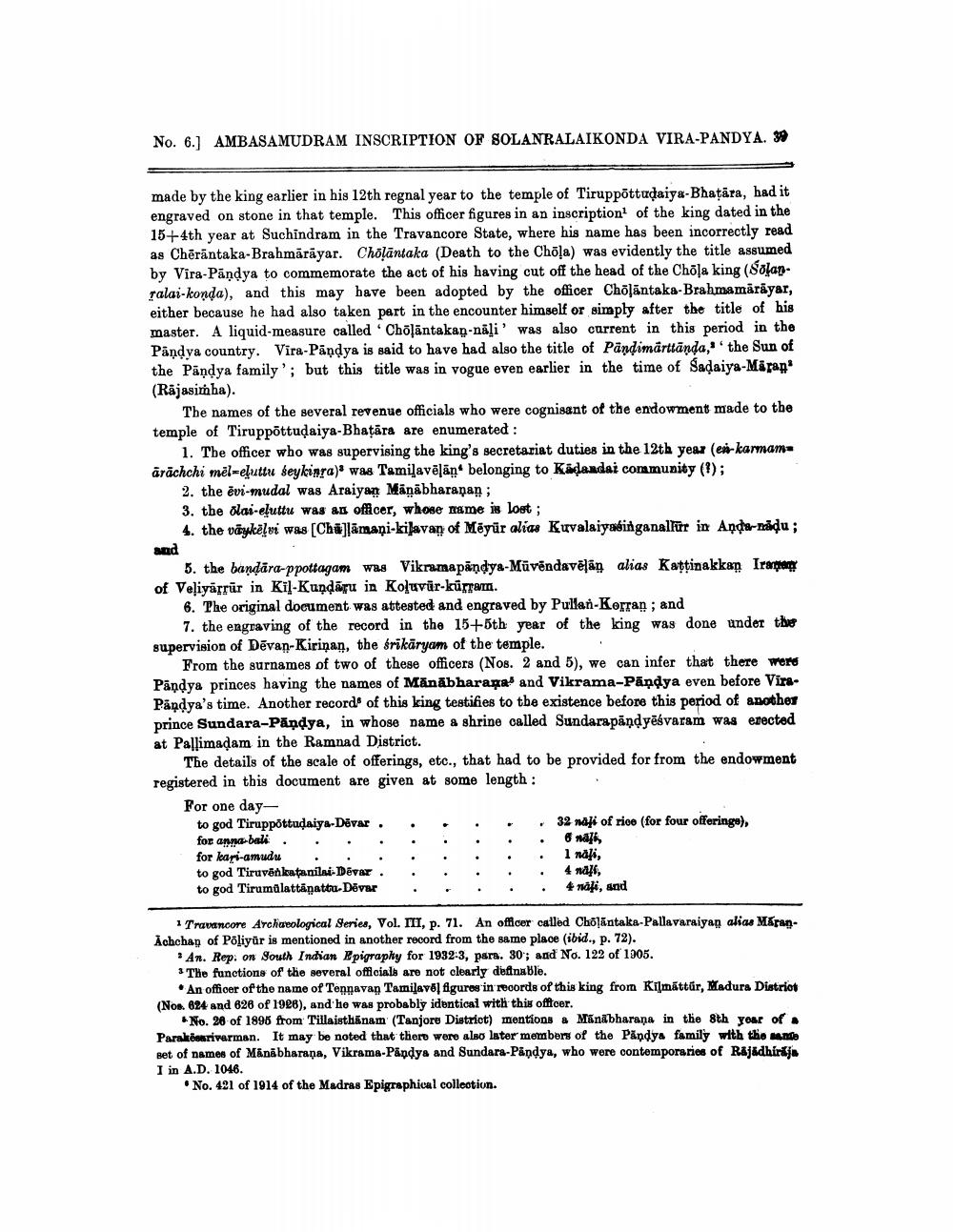________________
No. 6.) AMBASAMUDRAM INSCRIPTION OF SOLANRALAIKONDA VIRA-PANDYA. 39
made by the king earlier in his 12th regnal year to the temple of Tiruppõttudaiya-Bhatāra, had it engraved on stone in that temple. This officer figures in an inscription of the king dated in the 15+4th year at Suchindram in the Travancore State, where his name has been incorrectly read as Chērāntaka-Brahmārāyar. Chölāntaka (Death to the Chõļa) was evidently the title assumed by Vira-Pāndya to commemorate the act of his having cut off the head of the Chola king (Solanralai-konda), and this may have been adopted by the officer Chölantaka-Brahmamäräyar, either because he had also taken part in the encounter himself or simply after the title of his master. A liquid-measure called 'Chõļāntakap-nāļi' was also current in this period in the Påndya country. Vira-Pāņdya is said to have had also the title of Pandimarttānda, the Sun of the Pandya family'; but this title was in vogue even earlier in the time of Sadaiya-Miran' (Rajasimha).
The names of the several revenue officials who were cognisant of the endowment made to the temple of Tiruppõttudaiya-Bhatāra are enumerated :
1. The officer who was supervising the king's secretariat duties in the 12th year (ex-karmama ärāchchi mėl-eluttu feykinra) was Tamilavēlān. belonging to Kindlaadai community (P);
2. the evi-mudal was Araiyan Mäņabharanan; 3. tbe vlas-eluttu was an officer, whose name is lost; 4. the väykēļvi was (Chă]ļāmaņi-kilavan of Mēgür alias Kuvalaiyasinganallur in Anda-nadu;
and
5. the bandāra-ppottagam was Vikramapāņdya-Mūvēndavēlān alias Kattinakkan Trapery of Veliyārrur in Kil-Kundāju in Koluvür-kurrar.
6. The original document was attested and engraved by Pullan-Korran; and
7. the engraving of the record in the 15+5th year of the king was done under the supervision of Dēvan-Kiriman, the frikäryam of the temple.
From the surnames of two of these officers (Nos. 2 and 5), we can infer that there were Pandya princes having the names of Mānābharaga and Vikrama-Pandya even before ViraPandya's time. Another records of this king testifies to the existence before this period of another prince Sundara-Pandya, in whose name a shrine called Sundarapand yēsvaram was erected at Pallimadam in the Ramnad District.
The details of the scale of offerings, etc., that had to be provided for from the endowment registered in this document are given at some length:
For one day
to god Tiruppottudaiya-Dēvar . . . . . 32 näfi of rice (for four offeringe), for anna-bali. . . . .
. . . 8 nafs for kari-amudu . . .
. . I nali, to god Tiruvēnkatanilai-Devar . .
. . 4 nalt, to god Tirumalattånattu. Dēvar
. : 4 nafi, and
1 Travancore Archaeological Series, Vol. III, p. 71. An officer called Cholántaka-Pallavaraiyan alias MáranAchchan of Poliyür is mentioned in another record from the same place (ibid., p. 72).
. An. Rep. on South Indian Epigraphy for 1932-3, para. 30; and No. 122 of 1905. * The functions of the several officials are not clearly definable.
• An officer of the name of Tennavan Tamilavő figures in records of this king from Kilmättür, Madura Distriot (Nos. 624 and 628 of 1988), and he was probably identical with this offfoer.
No. 28 of 1898 from Tillaisthānam (Tanjore District) mentions & Manabharana in the 8th your of Parakoonriverman. It may be noted that there were also later members of the Pandya family with the same Bet of names of Manabharana, Vikrama-Pandya and Sundara-Pandya, who were contemporaries of Rajadhiraja I in A.D. 1046.
No. 421 of 1914 of the Madras Epigraphical collection.




